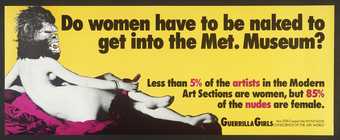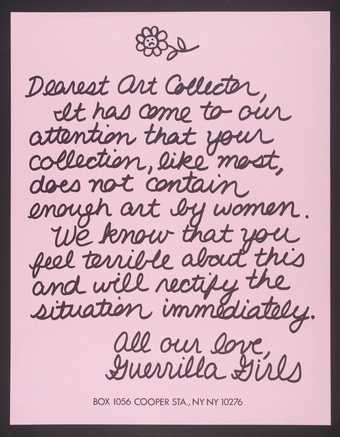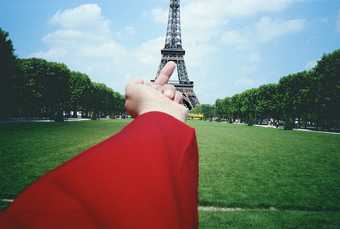Who are they?

Guerrilla Girls
Guerrilla Girls Review The Whitney, 1987
Screenprint on paper
560 x 432 mm
Guerrilla Girls are an all female collective who remain anonymous by wearing gorilla masks and naming themselves after famous dead women. In 1998 the Guerrilla Girls’ new book, The Guerrilla Girls’ Bedside Companion to the History of Western Art, they wrote:
We are a group of women artists and art professionals who fight discrimination. We’re the conscience of the art world, counterparts to the mostly male traditions of anonymous do-gooders like Robin Hood, Batman, and the Lone Ranger. We have produced over 80 posters, printed projects, and actions that expose sexism and racism in the art world and culture at large… We use humor to prove that feminists can be funny… We could be anyone; we are everywhere.

Guerrilla GirlsYou’re Seeing Less Than Half The Picture, 1989Screenprint on paper430 x 560 mm
How did they form?
The group famously began in reaction to MoMA’s An International Survey of Recent Painting and Sculpture 1984 exhibition. Although the exhibition was supposed to represent the top artists in the world, out of the 169 artists shown only 13 were women. To add insult to injury the curator, Kynaston McShine, stated in interviews that “any artist who wasn’t in the show should rethink ‘his’ career.”
A group of artists protested outside on the opening night. However, they noticed the onlookers weren’t interested in their message, so a year later Guerrilla Girls formed with the aim of finding new ways to revolt using street art.
Why show in the places they attack?
Although Guerrilla Girls began as an activist group, they have gradually been embraced by the artworld and have shown their work in galleries such as MoMa and Tate Modern. This is how they reconcile their popularity with their work:
What do you do when the art world you’ve spent your whole life attacking suddenly embraces you? Well… you take your critique right inside the joint. We dissed MoMA at its own symposium on feminism. We criticized the Tate Modern and the Istanbul Modern…. The response? After we made fun of the National Gallery of Art, they vowed to change their ways. Ditto the Tate Modern and MoMA.
Guerilla Girls, Interview magazine
What are their key works?

Guerrilla Girls,Do Women Have To Be Naked To Get Into the Met. Museum? 1989Screenprint on paper 280 x 710 mm
The original of Do Women Have to Be Naked to Get Into the Met. Museum? was produced in 1989 after members of the group walked through the Met and counted the ratio of female artists to female nudes. What they discovered was that ‘less than 5% of the artists in the Modern Art Sections are women, but 85% of the nudes are female’.
The figure in the image is taken from Odalisque and Slave painted by Jean-Auguste-Dominique Ingres. In order to reach their audience, the group rented advertising space on the New York buses. However, soon after ‘the bus company cancelled [their] lease, saying that the image … was too suggestive and that the figure appeared to have more than a fan in her hand.’

Guerrilla Girls
Guerrilla Girls’ 1986 Report Card, 1986
Screenprint on paper
560 x 430 mm
Guerrilla Girls’ 1986 Report Card lists 17 Galleries, comparing the figures of female artists exhibited between 1985-6 and 1986-7 in their recognisably bold monochrome style. This poster, and others from their portfolio Guerrilla Girls Talk Back, borrow elements from advertising and fly-posting. Many of these posters were pasted up on New York’s streets at night, following in the tradition of street-artists and activists.

Guerrilla Girls
Dearest Art Collector, 1986
Screenprint on paper
560 x 430 mm
Another motif used by the Guerrilla Girls, is this girly handwritten letter, Dearest Art Collector 1986. The pink paper and sad faced flower appear only to enhance their sarcasm. They have used this template for other public letters, most of which sign off with ‘We know that you feel terrible about this and will rectify the situation immediately’. As usual the joke is on the art collector.
What the critics say …
The posters were rude; they named names and they printed statistics. They embarrassed people. In other words, they worked
Susan Tallman, Arts Magazine
…waging what they call cultural warfare…where the main ammunition is wit
CNNKick-ass
Walter Robinson, Artnet Magazine
Guerilla Girls in quotes …
We don’t need money. We just need bananas
Kollwitz, The Independent
Artists should stop making art only for the one percent and start making some art for the rest of us
Interview Magazine
How can you really tell the story of a culture when you don’t include all the voices within the culture?
Kahlo, NY Times

